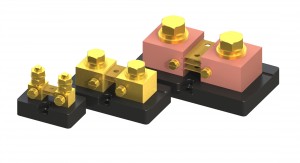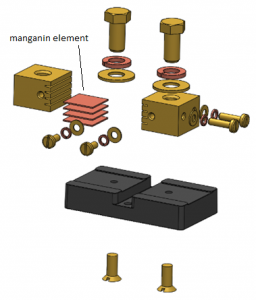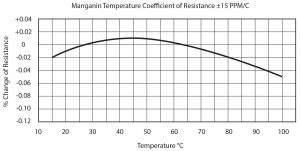DC Ammeter shunt –
The term DC ammeter shunt stems from one of the early uses of the devices as a means of measuring DC currents in a circuit utilizing a simple analog milli-volt meter. Many of the terms associated with these products are directly related to this application, although in simple terms a DC ammeter shunt is simply a precision current sensing resistor.
Rated current –
Shunts are specified first by choosing the chassis style, then the rated current followed by the corresponding milli-volt output. Often referred to as full-scale current, rated current is the current through the shunt that will result in a specified milli-volt value output.
Output voltage –
Current flowing through a shunt will produce a proportional voltage across the sensing terminals. When the rated current is flowing through the shunt, the output voltage will be as specified.
Resistance element –
Riedon utilizes a material known as Manganin as the resistance element for our shunts. Manganin is especially well suited to current measurement applications since it has a very low and predictable thermal coefficient of resistance (determines how the resistance changes with temperature), is fairly easy to form, and remains very stable over time.
Terminal block –
The terminal block is typically made of brass or copper and is where the high current wires or busbars are connected to the shunt as well as where the sensing terminals are located.
Sensing terminals –
The shunt will have a location for heavy, current carrying, conductors as well as two smaller terminals for attaching the voltage sensing wires. The resistance value and tolerance of the shunt is determined by measuring across the sensing terminals.
Derating –
For normal operating conditions we recommend customers operate the shunt at no more than 2/3 its rated current. This safety factor will prevent the component from overheating and ensure a long life.
Tolerance –
Riedon’s shunts have a standard tolerance of 0.25% and they are calibrated using NIST traceable components at room temperature. Calibration documentation is available on request and many of our models are available with tolerances as tight as 0.1%.
Power rating –
It is important to remember that the shunt will only need to dissipate the power generated by the voltage drop across the resistance element, not the power capabilities of the source. This power dissipation is governed by ohm’s law and results in very small power consumed by the device itself. For example, if we consider a 10 amp, 100mV shunt, the power at rated current may be calculated as P=I*V, or P=10*.1 or 1 watt.
Operating temperature –
Riedon shunts will perform most accurately between 30°C and 60°C. Shunts may certainly be operated at lower temperatures albeit with lower accuracy. The upper temperature of the resistance elements should be limited to 125°C for normal operation. If the element temperature exceeds 145°C permanent damage is likely to occur.
TCR –
Temperature coefficient of resistance or TCR refers to how the resistance value will change as a result of changes in temperature, including self-heating. Commonly measured in parts per million (ppm), the resistance element material we utilize, Manganin, has a typical TCR of 20ppm.



